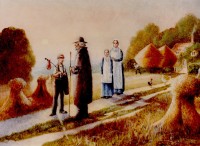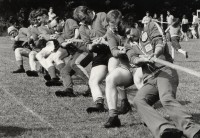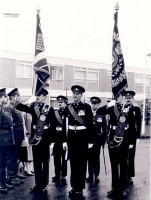Home of the Infantry Regiments of Berkshire and Wiltshire
Regimental Traditions
REGIMENTAL NICKNAMES
In the early days of the last century, regiments and corps were very often referred to by their nicknames, polite or otherwise, but one very seldom hears such a widespread use of them now, in spite of the fact that many were based upon praiseworthy episodes in regimental life. With a view to preserving some old nicknames from our regiment a list is shown below, with a brief note as to their origin. The work ‘nickname’ is derived from the fifteenth- century expression ‘an eke’.
ROYAL BERKSHIRE REGIMENT
The 49th Regiment (later 1st Battalion) were at one time known as ‘The Green Howard’s’ (Reference to green facings worn by the regiment at that time).
The Royal Berkshire Regiment were generally known as ‘The Biscuit Boys’ because the regimental depot, Brock Barracks’ was located at Reading, not far from the well known biscuit factory, Huntley and Palmers who were biscuit suppliers to the British Army for many years.

One take on the Moonrakers.
WILTSHIRE REGIMENT
The Wiltshire Regiment were known as ‘The Moon Rakers’ in allusion to the popular story of Wiltshire Rustics raking for the moon in a pond on a moonlight night when challenged by the Customs. The Regiment was also known as ‘the Wilts’, ‘The Splashers’, ‘The Springers’. The earliest nickname may have been the Splashers. This name came about from an incident during the Seven Years War at Carrickfergus in Ireland when the regiment ran out of ammunition and were forced to melt their buttons down to make musket balls. Thereafter, their buttons had a dent, known as a "splash". The next name, 'The Springers', came from the regiment being used in the light infantry role during the American Revolution at Saratoga. A common command for light infantry to advance while skirmishing in the 18th century was to "spring up". It is said that after the battle Major General Burgoyne rode along the decimated ranks of the 62nd, where only five officers and sixty men stood fit for duty, and said warmly 'Well done my brave Springers'. The nickname Moonrakers came from the Wiltshire region itself. According to legend, officials had captured some moonshiners pulling some kegs of alcohol out of a pond. The captured moonshiners tried to get away claiming that the rakes they were using to pull up the kegs were actually being used to retrieve cheese from the pond, actually the reflection of the moon in the water. Hence, they were raking the moon, or Moonrakers.
The second battalion of the Wiltshire Regiment (formerly the 99th Regiment) brought its own nicknames with them when the regiments were amalgamated in 1881. During its time as a separate regiment, the 99th Foot was known for its smartness and drill. This earned it an assignment guarding Queen Victoria’s pavilion in Aldershot in 1858. As a result the regiment became known as ‘The Queens Pets’. It is also said that the expression ’Dressed to the Nines’ originated as a reference to the 99th. As part of their drill, their uniforms were kept in immaculate condition which other regiments attempted to emulate, or dressing to the nines. [Researchers throughout the world have come up with many theories to establish that this was in use before 1858 and that it was linked to the regiment by virtue of the regimental numbers only].

The Farmer’s Boy.
DUKE OF EDINBURGH'S ROYAL REGIMENT
The regiment had no formal accepted nickname, although the ‘Farmers Boys’ was that which was most often applied to it by many within its ranks and some from outside the regiment. It was true to say that the warrant officers and sergeants probably adopted and used the nickname ‘Farmers Boys’ more than any other section of the regiment, and from time to time incorporated the title as a form of address into certain of their formal mess procedures.
A 1st Battalion nickname of ‘The Wonders’ was also in limited use during the early years of the regiment, and reflected the official operational abbreviation of “1 DERR” (which remained unchanged throughout the life of the regiment). However, this nickname never really achieved wider use, and various attempts from time to time to resurrect it in later years were generally short lived and finally unsuccessful.
Regimental Days
It is customary for each Regiment to select some outstanding achievement in the past, and to commemorate it each year in the form of a ceremonial parade, sports day, a ball or holiday. These are commonly called Regimental Days. On the formation of the Duke of Edinburgh's Royal Regiment it was decided to retain one each from the Royal Berkshire Regiment and the Wiltshire Regiment.


Maiwand Sports Day - Osnabruck West Germany early 1980's.
MAIWAND DAY
Although it would be natural to assume a battle celebrated would have been a victorious one, it is not in the case of ‘Maiwand Day’ taken from the Royal Berkshire Regiment. This was a defeat for the British forces in Afghanistan in 1880, but as you read the story of the battle you will appreciate just why it was decided to honour this day. Maiwand does not appear on the Colours or as a Battle Honour of the Regiment, but the award of "Kandahar 1880", in which the remains of the 66th played a small part. On the anniversary of this battle a families' sports day was normally held, followed by an all ranks dance.
FEROZESHAH DAY
Ferozeshah Day, taken from the battle fought by the 62nd Regiment over 21st and 22nd December 1845, was a victory for the Army, but the loss to the Regiment was great.


WO's and Sgt's Colour Party - Ferozeshah Parade Aldergrove 1986.
A Ceremonial Parade was held annually on which, in appreciation of the services rendered by the sergeants, the Colours were handed over by the Commanding Officer to the custody of the Warrant Officers and Sergeants of the battalion for the remainder of the day. A Sergeants Ball is held in the evening and the Colours handed back to the Officers at midnight.
The composition of the Colour Parties on this day differed from the normal one which is two Subalterns, a Warrant Officer Class II and two Sergeants. The Officers Colour party consists of two Subalterns and three Corporals. The Sergeants' Colour party consists of two Colour Sergeants, a Warrant Officer Class II and two sergeants.
Before the handover of the Colours from the Officers to the Sergeants, the Commanding Officer read out the charge:
"Warrant Officers and Sergeants of the Duke of Edinburgh's Royal Regiment. I am about to hand over to your custody for a period, the Colours of the 1st Battalion. This high honour is bestowed on you in commemoration of the gallant services rendered by your predecessors at the Battle of Ferozeshah, the anniversary of which we celebrate today. Safeguard and honour these Colours as your Officers have ever done and let the fact that our Colours are entrusted to your keeping be not only a reminder of past services but also a visible expression of the confidence and trust which to-day your Officers just place in you.
Hand over the Colours!”
Another unique custom on this parade was that the Regimental Sergeant Major alone commanded the Escort to the Colours, which was usually the Champion Drill Company.
The Vernon Bell
In 1758 four companies of the 62nd Foot (later 1st Battalion) were drafted to the Royal Navy for service as marines, and, under the command of Major Thomas Hardy, sailed in Admiral Boscawen’s fleet for the river St Lawrence, Canada. As a reminder of this service with the fleet the regiment played ‘Rule Britannia’ before the regimental march at the end of band programmes and observed the long established custom of striking ships time on a bell. The bell was struck every half-hour by a non commissioned officer of the guard room or Piquet, which ever was mounted at the guard room. This tradition was carried over into the Duke of Edinburgh’s Royal Regiment. The bell was presented to the Regiment by HMS VERNON, a naval shore establishment in Portsmouth, with whom there was an affiliation. This affiliation was at the request of the Duke of Edinburgh, who wished to continue the association of the Wiltshire Regiment and the Royal Berkshire Regiment with the Royal Navy, which had existed for over two hundred years. Throughout the day the bell was struck by the Regimental Police or Guard Commander to indicate the time of day, in the same manner as is the custom in the Royal Navy. The Regiment was the only Regiment to observe this custom.
Royal Berkshire Regiment customs
Officer's Mess Customs
Rolling in
Let it be explained at once that ‘Rolling in’ is not indicative of the gait of the offices as they went into dinner in the Royal Berkshire Regiment, but refers to the rolls on the side drums which played them in. One of the trophies the regiment acquired in the Crimean War was a small Russian side –drum.
At the weekly ‘Guest night’ (or band night, as it was called in some regiments), a drummer led the officers into the dining-room playing rolls on this drum. When the regiment went to the Great War of 1914 -18, the officers determined to capture a German side drum so that two drummers could ‘Roll in’ on guest nights, and this they did. The custom was observed in this manner, when the band played ‘The Roast Beef of Old England’ the two drummers led the officers from the ante room into the dinning room. One drummer went to one side of the dining table whilst the other took the other side. On arriving opposite the middle of the table the halted, but continued beating until all the officers are seated, whereupon they ceased, and withdrew. This tradition was still observed in the Duke of Edinburgh's Royal Regiment after amalgamation.
Kiss Me Lady
The heading is not intended to convey the impression that it is a request to a lady to indulge in a pleasant osculation in the officer’s mess; in fact it is the name of a catchy little tune also connected with the ritual that used to be observed at dinner in the Royal Berkshire Regiment. After the loyal toast had been drunk the band played this tune. The precise origin of the custom does not appear to have been established, but there is a legend to the effect that it was introduced several years ago by a somewhat amorous commanding officer who had been ‘smitten’ by a lady with whom he had danced to the tune.
White Tie Night
It was about the time of the Peninsula War that an interesting custom was initiated in the 66th Regiment. The story goes that the officers were invited to a ball by a distinguished French Lady. The Commanding Officer, out of consideration for a defeated enemy, ordered that plain clothes would be worn. However, the exigencies of the campaign had reduced the officer’s wardrobes, and some of them could not produce anything but uniform. They were promptly ordered to obtain civilian dress, and to ensure that they kept it with them it was ordained that the whole mess should dine in plain clothes once a year. This custom was honored as long as the regiment retained its identity and was known as ‘White tie night’. In the regiments bets and fine book there are a number of instances of officers being fined for not observing this custom.
The 1st Battalion was one of several regiments whose officers were called to dinner on special evenings by the old English song ‘The Roast Beef of Old England’ played by the band or the Corps of Drums in place of the more usual bugle call ‘Officers wives get puddings and pies, Soldier wives get skilly’.
Royal Gloucestershire, Berkshire and Wiltshire Regiment
The Regiment was not in existence long enough to obtain a nickname of any significance but because of the amalgamations and ever increasing size of the regimental title they obtained several, none of which stuck.
M4 Rifles
(Referring to the Motorway, M4 that runs the length of Berkshire and Wiltshire)
THE RIFLES
As a Rifle Regiment, a private soldier in The Rifles is known as a Rifleman and Serjeant is spelt in the archaic fashion; the regiment wears a Rifle green beret. A number of golden threads have been brought into the new regiment from each of its founder regiments.
Croix de Guerre – the French Croix de Guerre ribbon awarded to the Devonshire Regiment in World War one, and subsequently worn by the Devonshire and Dorset Light Infantry, is worn on both sleeves of No 1 and No 2 dress.
Back Badge – the badge worn on the back of the headdress that was awarded as an honour to the 28th Foot and subsequently worn by the Royal Gloucestershire, Berkshire and Wiltshire Light Infantry is worn on the forage cap and side hat, and on the shako of the regimental band and bugles.
Bugle Horn – the bugle horn badge of the Light Infantry, now surmounted by St. Edwards Crown, is the regiments cap badge.
Maltese Cross – the Maltese Cross of the Royal Green Jackets is worn as a buckle on the cross belt, and contains the regiments representative battle honours; currently one space is kept free foe future honours. In accordance with the tradition of rifle regiments, the regiment does not carry colours.
Black Buttons – the traditional black buttons of a rifle regiment are worn on all forms of dress with the exception of combat dress.
The units back badge reads Egypt, in honour of service by the 28th (North Gloucestershire) Regiment of Foot, one of the Rifles precursor units.
The rifles uniform, symbols, music customs and traditions are drawn from all the forming regiments, but the overall impression reflects the unifying military ethos of Sir John Moore’s Light Division, with its origins in the Peninsula War, a campaign in which all the forming regiments served with distinction, sharing battle honours. The uniform is green with black buttons and accoutrements, and with elements of red, recognising the heritage of our line regiments. The symbol and cap badge of The Rifles is the bugle. Battle honours are not worn n working dress; instead the selected symbols of the past are carried forward on parade uniforms. As a rifle regiment, battalions of The Rifles do not carry colours, instead battle honours are entrusted to each rifleman, who wears a representative selection of battle honours from all the forming regiments on the cross belts with the Inkerman whistle and chain, used in the past with the bugle to communicate with and direct riflemen. The bugle is central to the Rifles musical traditions but music has been carried forward from all our forming regiments. Daily routine in the battalion is marked by bugle calls. As so The Rifles sound, rather than beat retreat. The traditions and customs of all forming regiments are shared by The Rifles in their entirety, and so the Regiment celebrates the Battle of Salamanca, 1812 on the 22nf July as its annual Regimental Day.
The bugle is central the Rifles musical traditions but music has been carried forward from all our forming regiments.. Daily routine in the battalions is marked by bugle calls. And so The Rifles sound, rather than beat retreat. The traditions and customs of all forming regiments are shared by The Rifles in their entirety, and so the Regiment celebrates the Battle of Salamanca, 1812 on the 22nd July as its annual Regimental Day.